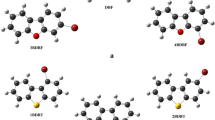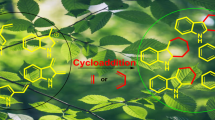Abstract
The Molecular Electron Density Theory (MEDT) was used for the study of the mechanism and the selectivity of the [3+2] cycloaddition reaction between quinazoline-3-oxide and methyl 3-methoxyacrylate, using the B3LYP/6-31G(d,p) DFT method. In gas phase, this [3+2] cycloaddition reaction is characterized by a completely ortho regioselectivity and a moderate exo stereoselectivity. Dichloroethane solvent did not modify the selectivities obtained in gas phase but increase the activation energies and decrease the exothermic character. Analysis of thermodynamic characters indicates that by the inclusion of the experimental conditions, the reaction becomes endergonic and thereby under thermodynamic control favouring the formation of the most stable product as observed experimentally, explaining the exo stereoselectivity. The analysis of the global electron density transfer (GEDT) at the transition states and bond order (BO) show that this reaction takes place via a very slightly synchronous and non-polar one-step mechanism. Conceptual DFT reactivity indices analysis accounts for the electrophilic character of the reagents, explaining the high obtained free activation energies, while local Parr functions analysis allows us to explain the ortho regioselectivity observed experimentally. ELF topological analysis of the most favoured reactive pathways indicates that mechanism of this 32CA reaction is one stage, one step, synchronous and non-concerted. The stability of the favourable cycloadduct is attributed to the presence of different non-conventional hydrogen bonds interactions as indicated by NCI and QTAIM analyses.

Graphical Abstract











Similar content being viewed by others
References
Gatadi S, Gour J, Shukla M, Kaul G, Das S, Dasgupta A, Malasala S, Borra RS (2018) Synthesis of 1, 2, 3-triazole linked 4 (3H)-quinazolinones as potent antibacterial agents against multidrug-resistant Staphylococcus aureus. Eur J Med Chem 157:1056–1067
Fan ZJ, Shi J, Bao XP (2018) Synthesis and antimicrobial evaluation of novel 1, 2, 4-triazole thioether derivatives bearing a quinazoline moiety. Mol Divers 22:657–667
Kapil S, Singh PK, Silakari O (2018) An update on small molecule strategies targeting leishmaniasis. Eur J Med Chem 157:339–367
Rahman MU, Rathore A, Siddiqui AA, Parveen G, Yar MS (2014) Synthesis and characterization of quinazoline derivatives: search for hybrid molecule as diuretic and antihypertensive agents. J Enzym Inhib Med Chem 29:733–743
Ugale VG, Bari SB (2014) Quinazolines: new horizons in anticonvulsant therapy. Eur J Med Chem 80:447–501
Patterson W, Cheung PS, Ernest MJ (1992) 3-Carboxy-5-methyl-N-[4-(trifluoromethyl) phenyl]-4-isoxazolecarboxamide, new prodrug for the antiarthritic agent 2-cyano-3-hydroxy-N-[4-(trifluoromethyl) phenyl]-2-butenamide. J Med Chem 35:507
Wagner E, Becan L, Nowakowska E (2004) Synthesis and pharmacological assessment of derivatives of isoxazolo [4, 5-d] pyrimidine. Bioorg Med Chem 12:265
Carrieri A, Muraglia M, Corbo F, Pacifico C (2009) 2D-and 3D-QSAR of Tocainide and Mexiletine analogues acting as Nav1. 4 channel blockers. Eur J Med Chem 44:1477
Gabrielsen M, Kurczab R, Siwek A, Wolak M, Ravna AW, Kristiansen K, Kufareva I, Abagyan R, Nowak G, Chilmonczyk Z, Sylte I, Bojarski AJ (2014) Identification of novel serotonin transporter compounds by virtual screening. J Chem Inf Model 54:933
Padwa A (ed) (1984) 1,3-Dipolar Cycloaddition Chemistry, vols. 1 and 2. Wiley/Interscience, New York
Yin Z, Li X, Deng Z, Yang Q, Peng Y (2020) The synthesis of isoxazolo [2, 3-c] quinazolines via a cycloaddition of quinazoline-3-oxides and acrylates. Tetrahedron Lett 61:151818
Houk KN (1975) Frontier molecular orbital theory of cycloaddition reactions. Acc Chem Res 8(11):361–369
Domingo LR (2016) Molecular electron density theory: a modern view of reactivity in organic chemistry. Molecules 21:1319–1334
Sobhi C, Khorief Nacereddine A, Djerourou A, Ríos-Gutiérrez M, Domingo LR (2017) A DFT study of the mechanism and selectivities of the [3+ 2] cycloaddition reaction between 3-(benzylideneamino) oxindole and trans-β-nitrostyrene. J Phys Org Chem 30(6):e3637
Nasri L, Ríos-Gutiérrez M, Nacereddine AK, Djerourou A, Domingo LR (2017) A molecular electron density theory study of [3+ 2] cycloaddition reactions of chiral azomethine ylides with β-nitrostyrene. Theor Chem Accounts 136(9):104
Ríos-Gutiérrez M, Nasri L, Khorief Nacereddine A, Djerourou A, Domingo LR (2018) A molecular electron density theory study of the [3+ 2] cycloaddition reaction between an azomethine imine and electron deficient ethylenes. J Phys Org Chem 31(6):e3830
Yahia W, Khorief Nacereddine A, Liacha M, Djerourou A (2018) A quantum-chemical DFT study of the mechanism and regioselectivity of the 1, 3-dipolar cycloaddition reaction of nitrile oxide with electron-rich ethylenes. Int J Quantum Chem 118(11):e25540
Barama L, Bayoud B, Chafaa F, Nacereddine AK, Djerourou A (2018) A mechanistic MEDT study of the competitive catalysed [4+ 2] and [2+ 2] cycloaddition reactions between 1-methyl-1-phenylallene and methyl acrylate: the role of Lewis acid on the mechanism and selectivity. Struct Chem 29(6):1709–1721
Chafaa F, Nacereddine AK, Djerourou A (2019) Unravelling the mechanism and the origin of the selectivity of the [3+ 2] cycloaddition reaction between electrophilic nitrone and nucleophilic alkene. Theor Chem Accounts 138(12):123
Lee C, Yang W, Parr RG (1988) Development of the Colle-Salvetti conelation energy formula into a functional of the electron density. Phys Rev B 37:785
Becke AD (1993) Density-functional thermochemistry. I. The effect of the exchange-only gradient correction. J Chem Phys 98:5648
Hehre WJ, Radom L, Schleyer PVR, Pople JA (1986) Ab initio molecular orbital theory. Wiley, New York
Tomasi J, Persico M (1994) Molecular interactions in solution: an overview of methods based on continuous distributions of the solvent. Chem Rev 94:2027
Frisch MJ, Trucks GW, Schlegel HB, Scuseria GE, Robb MA, Cheeseman JR, Scalmani G, Barone V, Mennucci B, Petersson GA, Nakatsuji H, Caricato M, Li X, Hratchian HP, Izmaylov AF, Bloino J, Zheng G, Sonnenberg JL, Hada M, Ehara M, Toyota K, Fukuda R, Hasegawa J, Ishida M, Nakajima T, Honda Y, Kitao O, Nakai H, Vreven T, Montgomery JA, Peralta JE, Ogliaro Jr F, Bearpark M, Heyd JJ, Brothers E, Kudin KN, Staroverov VN, Kobayashi R, Normand J, Raghavachari K, Rendell A, Burant JC, Iyengar SS, Tomasi J, Cossi M, Rega N, Millam JM, Klene M, Knox JE, Cross JB, Bakken V, Adamo C, Jaramillo J, Gomperts R, Stratmann RE, Yazyev O, Austin AJ, Cammi R, Pomelli C, Ochterski JW, Martin RL, Morokuma K, Zakrzewski VG, Voth GA, Salvador P, Dannenberg JJ, Dapprich S, Daniels AD, Farkas O, Foresman JB, Ortiz JV, Cioslowski J, Fox D (2009) Gaussian 09, Revision A.02. Gaussian, Wallingford
Reed AE, Curtiss LA, Weinhold F (1988) Intermolecular interactions from a natural bond orbital, donor-acceptor viewpoint. Chem Rev 88:899
Simkin BY, Sheikhet I (1995) Quantum chemical and statistical theory of solutions—computational approach. Ellis Horwood, London
Cances E, Mennucci B, Tomasi J (1997) A new integral equation formalism for the polarizable continuum model: theoretical background and applications to isotropic and anisotropic dielectrics. J Chem Phys 107:3032
Cossi M, Barone V, Cammi R, Tomasi J (1996) Ab initio study of solvated molecules: a new implementation of the polarizable continuum model. Chem Phys Lett 255:327
Barone V, Cossi M, Tomasi J (1998) Geometry optimization of molecular structures in solution by the polarizable continuum model. J Comput Chem 19:404
Becke AD (1993) Density-functional thermochemistry. III. The role of exact exchange. J Chem Phys 98:5648
Parr RG, von Szentpaly L, Liu S (1999) Electrophilicity index. J Am Chem Soc 121:1922
Parr RG, Pearson RG (1983) Absolute hardness: companion parameter to absolute electronegativity. J Am Chem Soc 105:7512
Parr RG, Yang W (1989) Density functional theory of atoms and molecules. Oxford University Press, New York
Domingo LR, Pérez P, Sáez JA (2013) Understanding the local reactivity in polar organic reactions through electrophilic and nucleophilic Parr functions. RSC Adv 3:1486
Johnson ER, Keinan S, Mori-Sanchez P, Contreras-Garcia J, Cohen J, Yang AW (2010) Revealing noncovalent interactions. J Am Chem Soc 132:6498
Lane JR, Contreras-Garcia J, Piquemal JP, Miller BJ, Kjaergaard HG (2013) Are bond critical points really critical for hydrogen bonding? J Chem Theory Comput 9:3263
Contreras-Garcia JE, Johnson R, Keinan S, Chaudret R, Piquemal JP, Beratan DN, Yang W (2011) NCIPLOT: a program for plotting noncovalent interaction regions. J Chem Theory Comput 7:625
Bader RFW (1990) Atoms in molecules. A quantum theory. Claredon Press, Oxford
Lu T, Chen F (2012) Multiwfn: a multifunctional wavefunction analyzer. J Comput Chem 33:580
Domingo LR (2014) A new C–C bond formation model based on the quantum chemical topology of electron density. RSC Adv 4:32415–32428
Reed AE, Weinstock RB, Weinhold F (1985) Natural population analysis. J Chem Phys 83:735–746
Becke AD, Edgecombe KE (1990) A simple measure of electron localization in atomic and molecular systems. J Chem Phys 92:5397–5403
Geerlings P, De Proft F, Langenaeker W (2003) Conceptual density functional theory. Chem Rev 103:1793–1873
Domingo LR, Ríos-Gutiérrez M, Pérez P (2016) Applications of the conceptual density functional theory indices to organic chemistry reactivity. Molecules 21:748
Benchouk W, Mekelleche SM, Silvi B, Aurell MJ, Domingo LR (2011) Understanding the kinetic solvent effects on the 1,3-dipolar cycloaddition of benzonitrile N-oxide: a DFT study. J Phys Org Chem 24:611
Wiberg KB (1968) Application of the pople-santry-segal CNDO method to the cyclopropylcarbinyl and cyclobutyl cation and to bicyclobutane. Tetrahedron 24:1083
Domingo LR, Aurell MJ, Pérez P, Contreras R (2002) Quantitative characterization of the global electrophilicity power of common diene/dienophile pairs in Diels-Alder reactions. Tetrahedron 58:4417
Nacereddine AK, Sobhi C, Djerourou A, Ríos-Gutiérrez M, LR D (2015) Non-classical CH...O hydrogen-bond determining the regio- and stereoselectivity in the [3 + 2] cycloaddition reaction of (Z)-C-phenyl-Nmethylnitrone with dimethyl 2-benzylidenecyclopropane-1,1-dicarboxylate. A topological electron-density study. RSC Adv 5:99299
Hellel D, Chafaa F, Nacereddine AK, Djerourou A, Vrancken E (2017) Regio-and stereoselective synthesis of novel isoxazolidine heterocycles by 1, 3-dipolar cycloaddition between C-phenyl-N-methylnitrone and substituted alkenes. Experimental and DFT investigation of selectivity and mechanism. RSC Adv 7:30128–30141
Lachtar Z, Nacereddine AK, Djerourou A (2020) Understanding the origin of the enantioselectivity and the mechanism of the asymmetric reduction of ketimine generated from acetophenone with oxazaborolidine catalyst. Struct Chem 31(1):253–261
Chafaa F, Nacereddine AK, Djerourou A (2020) A combined topological ELF, NCI and QTAIM study of mechanism and hydrogen bond controlling the selectivity of the IMDC reaction of nitrone-alkene obtained from m- allyloxybenzaldehyde. Lett Org Chem 17:260–267
Rozas I, Alkorta I, Elguero J (2000) Behavior of ylides containing N, O, and C atoms as hydrogen bond acceptors. J Am Chem Soc 122:11154
Grabowski SJ, Sokalski WA, Dyguda E (2006) Leszczynski, J. Quantitative classification of covalent and non-covalent H-bonds. J Phys Chem B 110:6444
Author information
Authors and Affiliations
Corresponding author
Additional information
Publisher’s note
Springer Nature remains neutral with regard to jurisdictional claims in published maps and institutional affiliations.
Electronic supplementary material
ESM 1
(DOCX 81 kb)
Rights and permissions
About this article
Cite this article
Khorief Nacereddine, A. A MEDT computational study of the mechanism, reactivity and selectivity of non-polar [3+2] cycloaddition between quinazoline-3-oxide and methyl 3-methoxyacrylate. J Mol Model 26, 328 (2020). https://doi.org/10.1007/s00894-020-04585-0
Received:
Accepted:
Published:
DOI: https://doi.org/10.1007/s00894-020-04585-0




